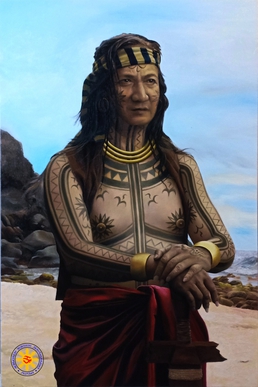The Battle of Mactan was fought on a beach in Mactan Island between Spanish forces led by the Portuguese explorer Ferdinand Magellan along with local allies, and Lapulapu, the chieftain of the island, on the early morning hours of April 27, 1521. Magellan, a Portuguese-born commander serving the Spanish Empire who led an expedition that ultimately circumnavigated the world for the first time, commanded a small Spanish contingent in an effort to subdue Mactan under the Spanish crown. The sheer number of Lapulapu's forces, compounded with issues associated with the location and the armor, ultimately resulted in a disastrous defeat to the Europeans and the death of Magellan. Surviving members of Magellan's crew continued the expedition under the command of Juan Sebastian de Elcano, who completed the journey in September 1522.

Lapulapu or Lapu-Lapu, whose name was first recorded as Çilapulapu, was a datu (chief) of Mactan, an island now part of the Philippines. Lapulapu is known for the 1521 Battle of Mactan, where he and his men defeated Spanish forces led by Portuguese explorer Ferdinand Magellan and his native allies Rajah Humabon and Datu Zula. Magellan's death in battle ended his voyage of circumnavigation and delayed the Spanish occupation of the islands by over forty years until the expedition of Miguel López de Legazpi which reached the archipelago in 1565.

Lapu-Lapu, officially the City of Lapu-Lapu, is a highly urbanized city in the Central Visayas region of the Philippines. According to the 2020 census, it has a population of 497,604 people.

Mactan is a densely populated island located a few kilometers east of Cebu Island in the Philippines. The island is part of Cebu province and it is divided into the city of Lapu-Lapu and the municipality of Cordova.

Mactan–Benito Ebuen Air Base, originally known as Opon Airfield and later Mactan Air Base, is an active military airbase of the Philippine Air Force (PAF). It is located on the island of Mactan, Cebu, in the Visayas region of the Philippines. It shares its two runways with the civilian Mactan–Cebu International Airport. Mactan Air Base was originally built by, and was a facility of the United States Air Force (USAF), until the American military units left the country in 1991, whereby full and total control was handed over to the Philippine Air Force.
Rajah Humabon later baptized as Don Carlos Valderrama, was one of the recorded chiefs in Cebu who encountered Ferdinand Magellan in the 16th century. Humabon ruled at the time of the arrival of Portuguese-born Spanish explorer Ferdinand Magellan in the Philippines in 1521. Humabon, his wife, and his subjects were the first known Christian converts in the Philippines. However, since there were no Catholic priests in Cebu from 1521 to 1565, this Christianity was not practised until the return of the Spaniards to Cebu. There is no official record of Humabon's existence before the Spanish contact. The existing information was written by Magellan's Italian voyage chronicler, Antonio Pigafetta on Humabon and the indigenous Philippine peoples that existed prior to Spanish colonization. Rajah Humabon is cited as the reason for why Magellan fought in the Battle of Mactan, as the latter wanted to earn the trust of Humabon by helping him subdue his opponent Lapulapu, one of the chiefs of Mactan. Despite being referred to as "king" in the journal of Antonio Pigafetta, he was not one like in the manner of a monarch in centralized societies, it is plausible that the title was mistakenly applied because according to succeeding chroniclers, there were no kingdoms in the pre-colonial Philippines.

The National Historical Commission of the Philippines (NHCP) and its predecessor agencies install historical markers in the Philippines and overseas to signify important and historic events, persons, sites, structures, and institutions. The commemorative plaques are permanent signs installed by the NHCP in publicly visible locations on buildings, monuments, or in special locations. The NHCP also allows local municipalities and cities to install markers of figures and events of local significance, although these markers are barred from using the seal of the Republic of the Philippines.
1521 in the Philippines details events of note that happened in the Philippines in the year 1521.

The Statue of the Sentinel of Freedom or the Lapu Lapu Monument is a monument to Lapulapu formerly located at the center of the Agrifina Circle at Rizal Park in Manila, Philippines.

The 2021 Quincentennial Commemorations in the Philippines was a series of observances organized to mark the 500th anniversary of various events in the Philippines, notably the introduction of Christianity in the Philippines, the role of the country in the Magellan–Elcano circumnavigation, and the victory of Lapulapu in the Battle of Mactan.
"Panalo" (transl. "Victory") is a song by Filipino-American rapper Ez Mil, released on July 26, 2020, as the fifth track on the album Act 1. It features lines in three languages: Filipino/Tagalog, English, and Ilocano in the original Wish 107.5 recording with an addition of Cebuano for the following Pacquiao Version official music video release.
The Lapulapu Memorial Shrine and Museum is a proposed museum and monument to Lapulapu to be built at Mactan Shrine in Lapu-Lapu City, Philippines.

The 500 Years of Christianity in the Philippines was a quincentennial observed in the Philippines. It was held from April 4, 2021, to April 22, 2022, to commemorate the introduction of Christianity in the Philippines in 1521 when the Magellan expedition made a stopover in the islands.

1521 is a 2023 historical drama film written by Mary Krell-Oishi and directed by Michael Barder. A Philippine-American co-production, it stars Danny Trejo, Bea Alonzo, Costas Mandylor, Michael Copon, Hector David Jr., Maricel Laxa, Vic Romano, Floyd Tena, Larissa Buendia. The film is based on the 1521 encounter of explorer Ferdinand Magellan and his crew, who were serving the Spanish Empire, with Lapulapu and other pre-Hispanic Philippine natives, as well as the love story between a native princess and a Spanish soldier.
Lapulapu or Lapu-Lapu was a datu of Mactan.















